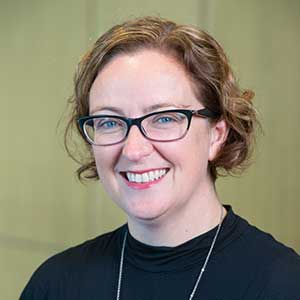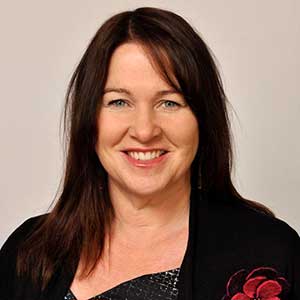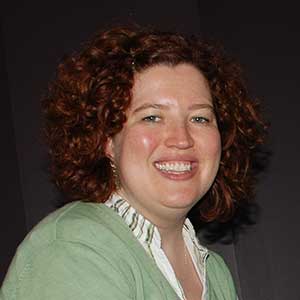All these questions, and many more, form the basis of a new exhibition called Waging Peace, which opened recently at UniSA’s futuristic museum of discovery, MOD.. Operating at the intersection of scientific research and artistic expression, Waging Peace challenges preconceptions about what peace means now and, perhaps more importantly, what it could mean in the future.
Beyond the peace clichés

MOD. director Dr Kristin Alford says the exhibit challenges people to rethink the tendency to fall into “old-fashioned, obsolete notions of what peace is”.
“It seemed that the general view of peace wasn’t sufficient to drive action,” she says. “We approached the idea with
a rule about ‘no doves, no flowers, no tanks’ as we wanted to get people thinking in new ways. Thinking about the hard work of justice, of making sure that people have good governance and safe places to live. And it’s not just preventing war – it’s far more active and engaged than that.”
In exploring such an expansive perspective, the Waging Peace exhibition is underpinned by a detailed research project by UniSA’s Ehrenberg-Bass Institute for Marketing Science, which approached peace as if it were like any other brand, an identity that could be understood and improved. Researchers surveyed more than 400 South Australians to canvass impressions and connections that exist around peace, with some intriguing results.

The Ehrenberg-Bass Institute’s Associate Professor Anne Sharp says some of the findings were in line with stereotypes.
“We found that people connect peace with the stereotypical images, like peace signs and doves,” she says. “Outside of that imagery, however, there’s not as much going on in people’s heads as we might have thought. Peace is strongly linked with nature, but apart from that people found it really hard to think of any other kind of imagery or associations.”
The Ehrenberg-Bass Institute’s findings feature as a series of infographics at the exhibition, serving as a visual manifestation of the most fundamental ideas guiding the exhibition (see right). Many of the other elements on display, however, reflect much of the ambiguity surrounding the subject, and represent far less obvious incarnations of the peace ideal.
After developing the concept for the exhibition, MOD. put out an open call for artists and researchers to respond with ideas. Dr Alford says they also approached researchers with some ideas of their own.
“It was a great collaborative process
that helped identify things that might be a little bit unexpected, revealing different ways of connecting peace to our everyday lives,” Dr Alford says.
How a good night’s sleep can support peace

One of the exhibit’s major installations explores a commonly overlooked contributor to peace – sleep. Based around a collection of interactive ‘sleep pods’, the display translates and transforms the work of Associate Professor Siobhan Banks, co-director of UniSA’s Behaviour-Brain-Body Research Centre. Assoc Prof Banks’ research into sleep deprivation has been utilised by institutions including the US Air Force, NASA, Thales UK, Lockheed Martin and Australia’s Defence Science and Technology Group, and emphasises the importance of sleep for mental health and decision making.
“Sleep deprivation is what a lot of people in the military and many other professions go through,” Assoc Prof Banks says. “My research looks at ways to mitigate and manage that, to encourage industry to view sleep requirements as a serious consideration. If you sleep more, your decision making is better, your conflict resolution skills are better, you are more tolerant and patient, so when places like hospitals or the military don’t put sleep
as a priority, not only will their personnel’s health and cognitive performance be affected, but overall safety as well.”
In the context of South Australia’s changing economic landscape, in which the defence industry is emerging as a key sector, the questions posed by MOD.’s adaptation of Assoc Prof Banks’ research are far reaching and timely. As Dr Alford stresses, it would be irresponsible not to have a public conversation around such a direction, and the medium afforded by MOD. allows for the scientific and the social to be given equal consideration.
“Part of what we’re trying to do is change the culture of conversation around the role of science and technology in this State, but to do that in a way that is that is relevant for people and sits at that intersection of science and society. When you think about attracting young adults to STEM, the defence industry plays a big role, and we want to ask questions that ensure the best outcomes follow from that.”
Virtual reality to create ‘peace’ in a war zone
In a similar vein, Waging Peace also includes a fully interactive augmented reality experience recreating a deployable field hospital developed by Saab for use in emergency and conflict scenarios. Using Microsoft’s HoloLens mixed-reality glasses, visitors either freely explore the virtual hospital or navigate through a scenario based on a chosen role, such as a surgeon or technician, for a more immersive and directed experience.
“Saab uses the HoloLens for testing a lot of their designs, and this is a really interesting example of employing those sorts of technologies to optimise a life-saving system, and actively building a healthy, peaceful environment in a situation that is far from that initially,” Dr Alford says.
The potential the virtual world offers for building peace is further highlighted through the exhibition’s integration of a selection of games – both board and video – that go against the grain of glorified violence so common in the gaming world. MOD. visitors can play a of range peace-promoting games, including a title called Ninja Pizza Girl, created by Australian-based, family-run developer Disparity Games.
“Games are uniquely wonderful in teaching people empathy,” says Nicole Stark, who founded Disparity with husband Jason in 2011, and points to the influencenof her four daughters as key to the company’s positive ethos.
“In a game, you literally walk in someone else’s shoes, and I don’t think there’s anything else that does that to the same extent. They can definitely be a force for good, and there’s definitely been a change in recent years. There are a lot more games coming out with more positive themes, which are attracting a different audience, including young girls who don’t want to play games about killing. Hopefully that becomes a creative cycle and they end up creating things that are even more powerful.”
It’s just such a cycle that MOD. is hoping to inspire and encourage with Waging Peace – promoting the idea that, ultimately, peace is something to be achieved, not just hoped for. Fittingly, included among its many elements are a number of creations from South Australian school kids, who were asked to design a ‘peace machine’. Like the idea behind the entire exhibition, it’s a curly challenge, but sometimes that’s just the point.
“You know,” says Dr Alford, “traditionally, we think about the hawks of war and the doves of peace, but maybe there are other ways to look at it.”